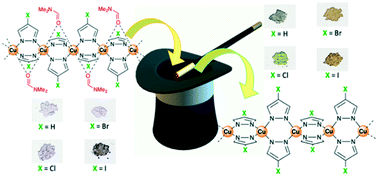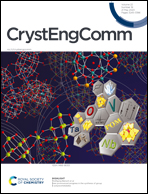Investigation on the interconversion from DMF-solvated to unsolvated copper(ii) pyrazolate coordination polymers†
Abstract
A series of copper(II) pyrazolates were synthesized employing different synthetic approaches. By refluxing either [Cu3(μ3-OH)(μ-pz)3(CH3COO)2(pzH)] (pzH = pyrazole) or [Cu(μ-pz)2·H2O]n in water, [Cu(μ-pz)(μ-OH)]n (1) was unexpectedly obtained, whereas the reactions of copper(II) acetate hydrate with pzH or 4-XpzH (4-XpzH = 4-Xpyrazole, X = Cl, Br, I) in dimethylformamide (DMF) by microwave-assisted solvothermal syntheses yielded the compounds [Cu(μ-pz)2(μ-DMF)]n (2DMF) or [Cu(μ-4-Xpz)2(μ-DMF)]n (3DMF–5DMF). As unveiled by powder X-ray diffraction, all these compounds are 1-D coordination polymers showing square planar trans-CuN2O2 (1) or octahedral trans-CuN4O2 (2DMF–5DMF) metal centers, reasonably involved in through-bond antiferromagnetic interactions (magnetic susceptibility in the range 0.91–1.56 B.M.). Theoretical calculations carried out on these compounds at the B3LYP-D* level confirmed the structural aspects and IR spectroscopy features unveiled experimentally. Upon heating, 2DMF–5DMF reversibly lose DMF to give the corresponding low-crystallinity coordination polymers [Cu(μ-pz)2]n (2) and [Cu(μ-4-Xpz)2]n (3–5), of which only 3 was characterized in the past. In order to shed light on the local-level structural features of 2, 4 and 5, UV-Vis-NIR absorption and fluorescence emission spectroscopy measurements were performed, the results suggesting a tetrahedral stereochemistry for the metal centres.



 Please wait while we load your content...
Please wait while we load your content...